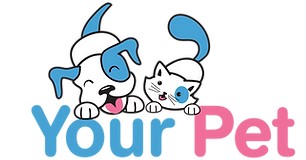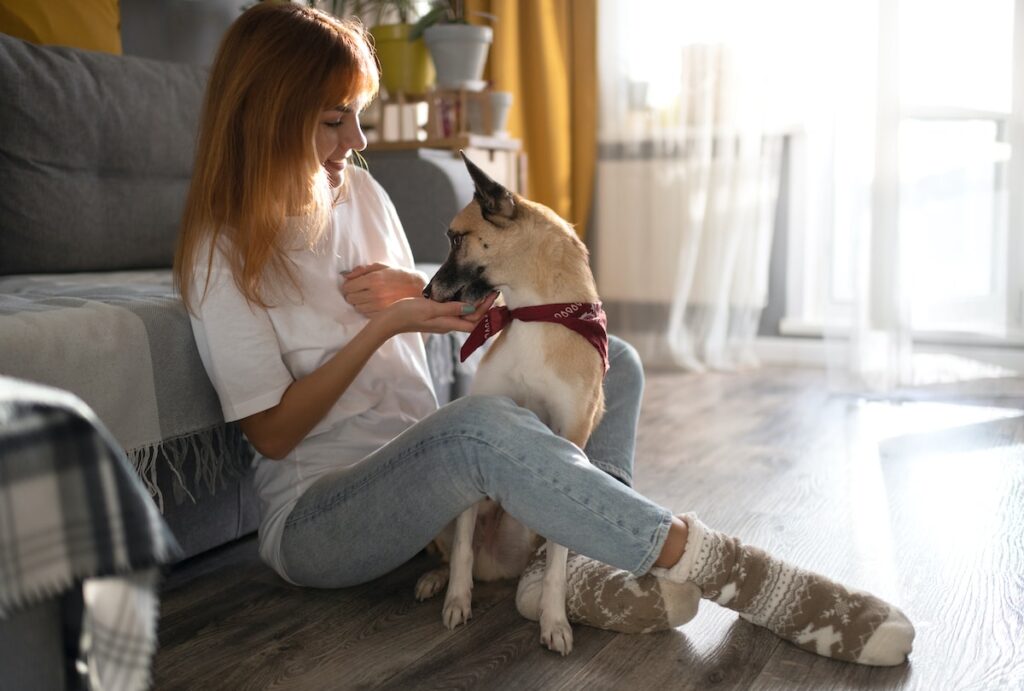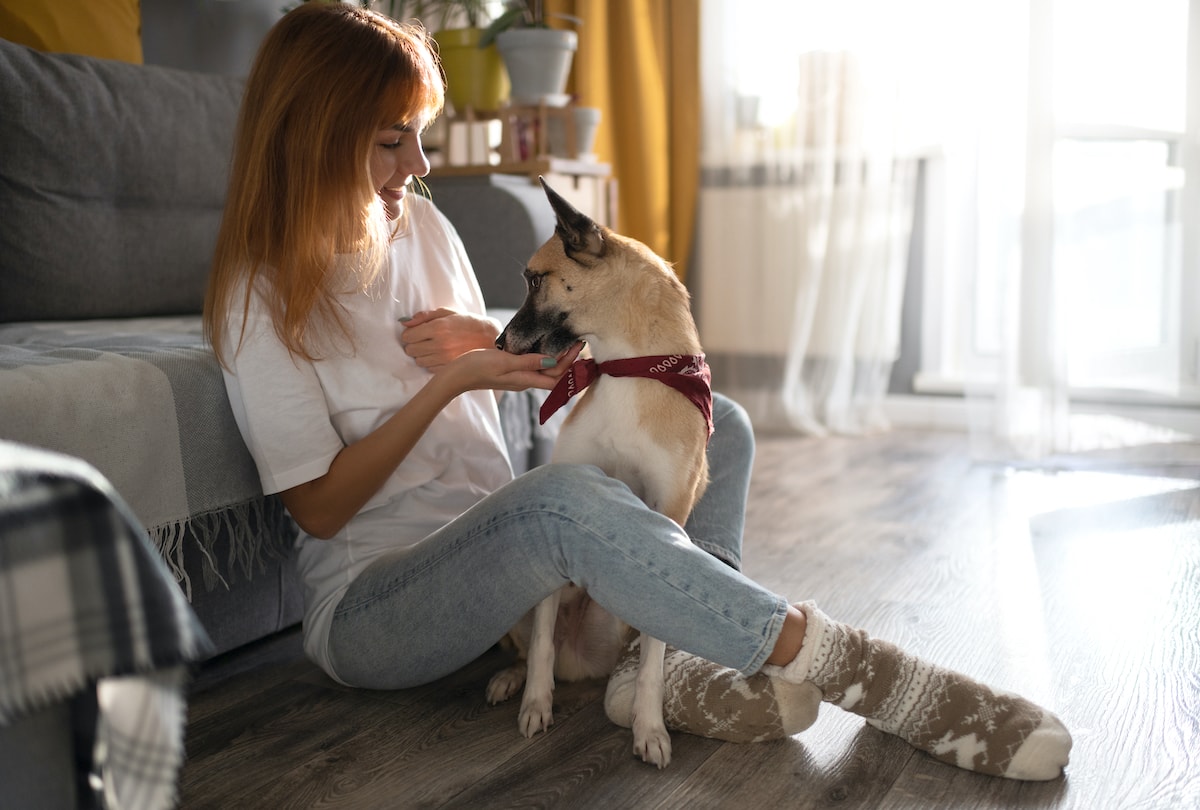
Optimistic reinforcement coaching is a canine coaching technique that focuses on rewarding good conduct somewhat than punishing unhealthy conduct.
An more and more in style coaching technique, optimistic reinforcement coaching can be known as R+ or force-free coaching, because it avoids the aversive strategies which are widespread to another approaches.
We’ll clarify why optimistic reinforcement coaching has turn out to be the coaching technique of selection and description the fundamentals of the strategy beneath!
What’s Optimistic Reinforcement Coaching?
Optimistic reinforcement coaching is all about reinforcing desired conduct by means of rewards.
Did you ever have a trainer rising up who gave you a bit of sweet for answering a query accurately? It is a nice instance of optimistic reinforcement!
You’ll want to determine a reward that can attraction to your pooch. Most certainly, the perfect reward can be noms!
Widespread Rewards for R+ Canine Coaching
Practically all canine are closely motivated by meals or high-value coaching treats, however goodies don’t must be the one method we reward canine for desired behaviors.
Different rewards we are able to provide our canine embrace:
- Reward
- Toys
- Video games (like a sport of fetch)
- Something a person canine finds rewarding
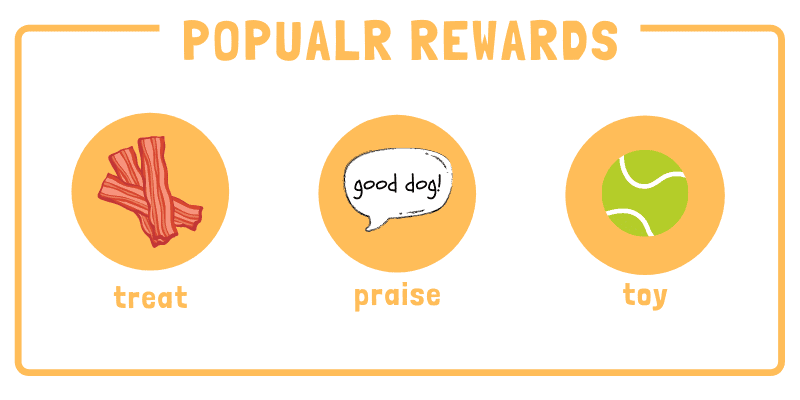
Meals is undoubtedly essentially the most highly effective motivator for many canine (particularly smelly meat treats), however different rewards can work properly too. Take into consideration your canine as a person and establish what they discover notably rewarding.
Can You Simply Use Reward to Practice Your Canine?
Many homeowners aspire to have their canine carry out desired behaviors for reward solely. In spite of everything, shouldn’t your canine need to please you on a regular basis? This expectation comes because of unhealthy mythologizing round canine.
Canine are animals who do what works for them.
They could love you very a lot, however they may carry out behaviors which are of their greatest curiosity. Meals is just essentially the most highly effective motivator for the overwhelming majority of canine.
It’s additionally essential to place your self within the thoughts of a canine. As house owners, we could assume {that a} pat on the top or a hug is a superb type of affection.
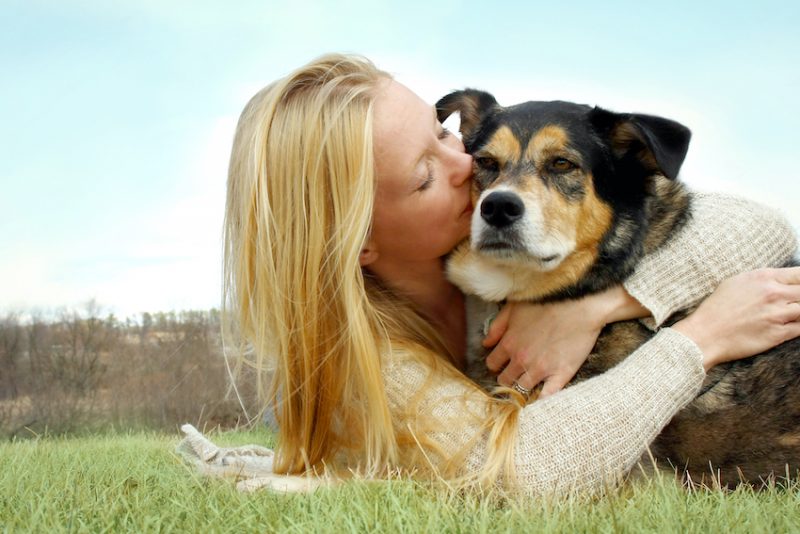 Not tremendous jazzed however don’t wanna be impolite
Not tremendous jazzed however don’t wanna be impolite
However in actuality, most canine don’t get pleasure from being patted on the top — they’d a lot desire a chin or butt scratch. And the vast majority of canine completely detest hugs, merely tolerating them for our sake.
As an alternative of specializing in what you suppose ought to be a superb reward on your canine, take into account what really will encourage your pooch in actuality.
Examples of Optimistic Reinforcement Coaching for Widespread Canine Points
Let’s have a look at some examples of how optimistic reinforcement is used when coping with undesired behaviors.
Downside: Your canine jumps up on you while you come residence.
Utilizing optimistic reinforcement, you wouldn’t knee your canine within the waist (a preferred old-school coaching approach) or shock them with a collar. As an alternative, you’d merely keep away from reinforcing the undesirable conduct by ignoring them. No consideration, no recognition, nothing. As soon as they’ve all 4 paws on the bottom, you’d reinforce the specified conduct (paws on the bottom) with reward, consideration, and treats.
Downside: Your canine barks on the mailman when he drops off a package deal on the door.
Utilizing optimistic reinforcement, you wouldn’t fiddle with a bark collar or yell at your canine to be quiet. As an alternative, you’d reward your canine the second he stops barking, even when it’s simply to take a deep breath or since you walked over to him.
You’d proceed to easily look ahead to the second your canine pauses his barking and reward him for that second of silence. Proceed to reward your canine for silence, even whether it is momentary and adopted by extra barking. As your canine learns that he’s getting treats solely when he stops barking, he’ll start to decide on to have a look at you rather than barking up a storm when he sees the mailman. Quickly the mailman himself can be related to tasty treats!
The Significance of Timing
Timing is extraordinarily essential for optimistic reinforcement coaching. For this technique to work, you could reward your canine instantly after he performs the specified conduct.
Let’s say you’re educating your canine to take a seat.
He performs the sit as desired, so that you go to seize him a deal with. As you come back and provides your canine the deal with, he’s stood up. Now you’ve rewarded the standing – not the sitting!
As a result of timing is so essential, optimistic reinforcement often necessitates using a handy deal with pouch . Many trainers additionally implement a coaching clicker, which can be utilized to be extra precise with timing.
![]()
What Are the Advantages and Drawbacks of Optimistic Reinforcement Coaching?
Optimistic reinforcement-based coaching gives some vital advantages, together with:
- Extra belief between you and your canine
- A deeper, richer bond
- Higher communication and understanding of each other
- Constructing a optimistic affiliation round people on the whole
- It’s secure for teenagers to interact in
Optimistic reinforcement coaching solely has one vital downside: It requires plenty of endurance.
The reality is that optimistic reinforcement can take a while to bear fruit when combating drawback behaviors. It’s because the proprietor should wait till their canine makes the proper selection, and should reinforce these good selections many instances for it to turn out to be engrained.
An important instance? Educating your canine to not bark at friends.
Picture a state of affairs the place you invite a visitor into your private home and your canine begins barking at her.
With optimistic reinforcement coaching, you’ll merely let your canine bark when you ignore the conduct. As quickly as he stops barking – even only for a second – you’ll reinforce his silence with a deal with.
You’ll be able to see that is the place a clicker turns out to be useful as an amazing help for optimistic reinforcement coaching.
In some circumstances, you are attempting to bolster a really temporary second of excellent conduct, and a clicker is usually a large help in a state of affairs like this (don’t fear, we’ll discuss extra concerning the professionals and cons of clickers beneath).
You’d proceed to reward your canine for being quiet within the presence of the stranger. The primary few instances a customer comes over, you’ll possible have to reward him for even a split-second of silence.
However, as coaching goes on, you’ll up the ante and solely reward him for each 3 seconds of silence.
Then you definately’ll need to wait for five seconds, then 10 seconds, and so forth. Till ultimately, your canine has little interest in barking at strangers as a result of he is aware of now that he’ll get rewarded for silence.
What Treats Are Greatest For Optimistic Reinforcement Coaching?
Optimistic reinforcement requires that you just share high-value rewards along with your pooch — that’s how you retain him motivated.
Some canine can be motivated by kibble when engaged on primary instructions, however more difficult methods and conduct modification requires tastier treats!
What number of children are motivated extra by Fig Newtons over Oreos? Most likely not too many…
One of the best treats for coaching are often:
- Pungent (often meat-based odors work greatest)
- Small (you’ll be utilizing plenty of treats in a coaching session, so the smaller is healthier)
- Delicate (crunchy treats take too lengthy on your canine to eat)
- Novel (new treats are at all times extra thrilling to canine than a deal with they already obtain repeatedly)
When Can I Cease Giving My Canine Treats?
Initially, you’ll need to reward your canine every time he performs the specified conduct.
As soon as your canine has a agency grasp on the conduct you need, you may start to dispense treats intermittently, however at all times reward with reward.
You can begin tapering down by rewarding with treats three out of 4 instances, two out of 4 instances, and so forth. Nonetheless, you’ll by no means need to cease rewarding with treats completely.
Treats ought to proceed for use intermittently for rewarding even long-established conduct for additional reinforcement.
Wait – you imply I ALWAYS have to offer my canine treats?
Sure and no.
You’ll at all times want treats to bolster a superb conduct, however as your canine will get higher at performing the specified conduct, treats can turn out to be much less frequent.
The thought is that ultimately, with plenty of repetition, the specified conduct (for instance, your canine not barking at strangers) will turn out to be the default conduct he merely performs out of behavior.
Nonetheless, you’ll at all times want to offer him treats periodically. It is best to do that even with a canine who hasn’t barked at a visitor in weeks!
How lengthy would you’re employed with out getting paid?
Trainers like to make use of the comparability of deal with dishing out to getting paid. How lengthy would you retain working at your job with out getting paid?
Don’t anticipate your canine to proceed to be just right for you except he’s paid adequately too!
As soon as a conduct is properly established, it’s also possible to start to go decrease on the hierarchy of rewards. As an alternative of utilizing smelly freeze-dried liver, you may use kibble.
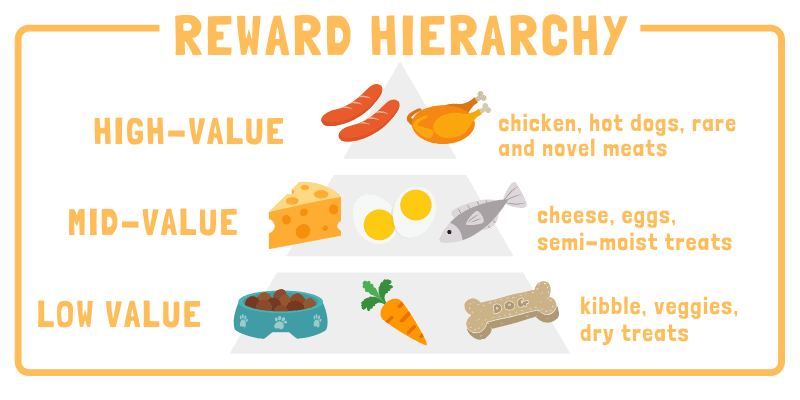
Nonetheless, be certain to not cut back reinforcement too shortly whereas concurrently decreasing the worth of the reward. Doing each without delay could make your canine backtrack, damaging all of your laborious work!
Should you’re questioning when you may cease giving treats fully, the reply is NEVER!
You’ll at all times have to proceed to bolster good conduct, even when the frequency required is much less.
Motivating Your Canine: You’ll All the time Want To Select Between the Carrot and the Stick
Detractors of optimistic reinforcement wish to label R+ trainers as “cookie pushers.”
It’s true that treats are an enormous a part of optimistic reinforcement coaching, however they don’t must be the one kind or reinforcement you present. Some canine will take into account a fast sport of fetch or tug as a implausible reward!
Nonetheless, for many house owners, treats are the best possibility. Whereas your canine could love reward, it’s not often fairly sufficient incentive for many doggos.
Right here’s what many of us don’t appear to grasp about canine: One thing will at all times be driving your canine’s conduct.
Nobody on this huge inexperienced earth does something for nothing, and you’ll have to select between the carrot and the stick.
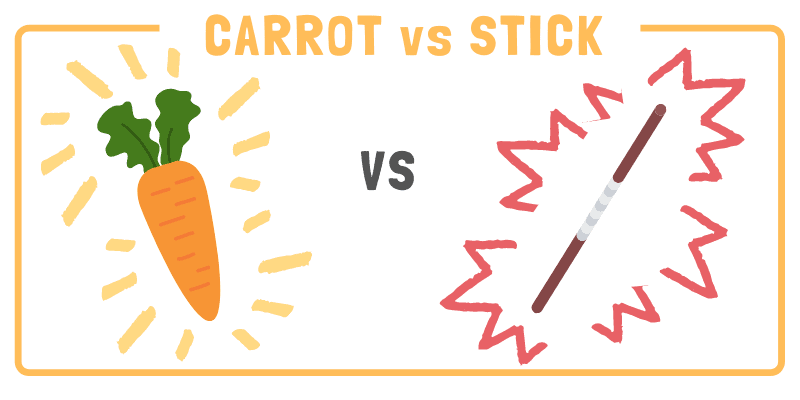
With optimistic reinforcement coaching, what’s driving your canine’s conduct is cookies. However for aversive coaching, what’s driving your canine’s conduct is worry and ache. I’d a lot somewhat be a deal with slinger to my canine than use bullying intimidation techniques to make him afraid of me.
Additionally understand that there must be continued reinforcement when coaching with aversives too.
Most canine who study to not pull to keep away from ache whereas utilizing a prong collar will start pulling once more as soon as they notice they aren’t on a prong collar.
Most canine who study to not bark as a result of they’re shocked with a bark collar will start barking once more when the collar is eliminated.
No conduct your canine learns can be one and accomplished. Each conduct wants intermittent reinforcement to be maintained.
Should you discovered how you can play the piano in highschool however didn’t contact a piano for 10 years, likelihood is you gained’t be taking part in Mozart the primary time you do follow once more.
Utilizing a Clicker in Optimistic Reinforcement Coaching
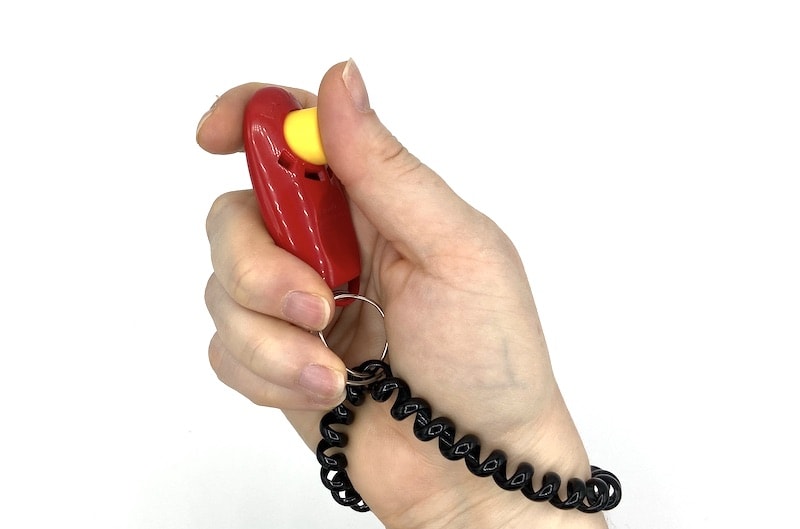
Clickers are small mechanical noise makers that emit a (look ahead to it…) clicking sound when pressed.
They’re usually thought-about a staple in optimistic reinforcement coaching, however they’re under no circumstances required – loads of house owners select to make use of a marker phrase like “sure” as a substitute of a clicker.
First Issues First: You Need to “Cost” a Clicker
When clicker coaching a canine, step one is to at all times “cost” the clicker.
Charging the clicker refers to creating an affiliation between the clicker and a deal with.To start out charging a clicker, you’ll merely click on the clicker after which give your canine a deal with, a number of instances in a row.
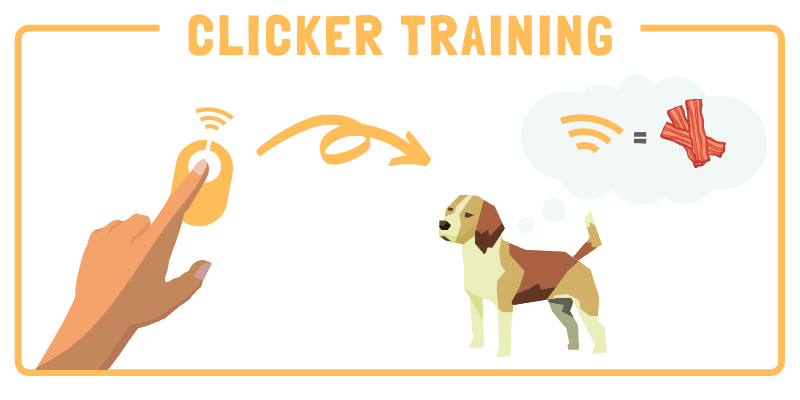
Quickly, your canine will hear the clicker and anticipate a deal with.
As soon as your canine has established the connection that click on = deal with, the clicker turns into a affirmation to the canine that he has carried out the proper conduct and that his reward is on the best way. This provides you a bit extra time to bodily get the deal with out and dispense it to your canine.
Utilizing a clicker permits you to be extremely exact with coaching, and reward your canine the precise second his butt hits the bottom when educating a “sit”.
Nonetheless, even as soon as your canine hears the press and associates it with a job properly accomplished, it’s important to at all times again up the press with an precise deal with. In any other case, the clicker will lose a lot of its energy and affect.
You’ll be able to take into consideration the press from a clicker a bit like when a toddler will get a ticket from an arcade. The ticket itself isn’t attention-grabbing, however the baby is aware of that they will redeem the ticket for a prize. Due to this affiliation, getting a ticket out of an arcade machine may be very thrilling!
However, if at some point the ticket was dropped at the counter and the arcade vendor refused to alternate it for sweet or a toy, the ticket would lose all worth. The following time a sport spit out a ticket, the kid wouldn’t be as excited since she or he would now not know for certain if it may very well be exchanged for a prize.
Don’t Need to Use a Clicker? No Downside – Marker Phrases Work Too!
Some house owners select to make use of a marker phrase as a substitute of a clicker. A marker phrase is a brief, fast phrase to inform the canine they’ve carried out the specified conduct. Widespread marker phrases embrace “Sure,” “Proper,” “Acquired it.”
Keep away from widespread, usually used phrases like “Good canine” or “OK” for a marker phrase. These phrases are too generally was particular or distinctive sufficient on your canine to affiliate with a deal with.
Utilizing a phrase like “Good canine” as a marker phrase signifies that each time your pup hears somebody say “Good canine,” he’ll anticipate a deal with!
Now think about while you go to the park and strangers strategy your canine, telling him he’s a superb canine. He’s anticipating a deal with because you’ve been utilizing that as a marker phrase, however he doesn’t get diddly squat!
Properly, subsequent time you do a coaching session and use the “Good canine” marker phrase, he gained’t be as assured within the affiliation since he is aware of now that he doesn’t at all times get a deal with.
Being exact and precise is essential with optimistic reinforcement coaching!
Clicker-Coaching Supplies Consistency
One other advantage of utilizing a clicker is the consistency it gives.
Since a clicker sounds the identical regardless of who’s utilizing it, it’s straightforward for canine to transition their coaching from one particular person to the subsequent. Marker phrases could fluctuate in intonation and tone relying on who’s performing the coaching, probably including confusion for the animal.
Different Issues to Maintain in Thoughts With Optimistic Reinforcement Coaching
Now that we’ve defined the fundamentals of R+ coaching, we have to define just a few different belongings you’ll have to be conscious of when adopting this strategy.
Shaping Your Canine’s Habits: Typically, “Shut Sufficient” Counts!
One highly effective facet of optimistic reinforcement coaching is shaping conduct. Shaping refers to rewarding approximations of the conduct you might be searching for, even when your canine isn’t fairly 100% there.
In different phrases, your canine doesn’t have to nail a given conduct to earn his reward and make progress — you may reward him for getting shut. Then, with repetition and follow, he’ll slowly study to get the conduct excellent.
Correct Reward Placement Is Essential
Simply as timing is crucial for good coaching, correct deal with placement is important too. Small canine shouldn’t have to leap as much as get a deal with after performing a strong “sit” – in any other case, you’re rewarding him for leaping!
The identical holds true for educating a “go to your mattress” command. You’ll want to offer your canine treats on his mattress, even when meaning strolling throughout the room from the place you might be cooking within the kitchen to reward his continued keep.
Mastering a superb, correct deal with toss may also be useful. Lastly these years of highschool softball can come in useful!
Restrict the Distractions & Select Quiet Environments
For all coaching, it’s greatest to begin out indoors, the place distractions are restricted. Remember the fact that your canine could nail a conduct or command indoors, solely to wrestle while you transfer outside.
The surface world gives ample distractions on your canine, and it may be very tough for him to remain centered on you.
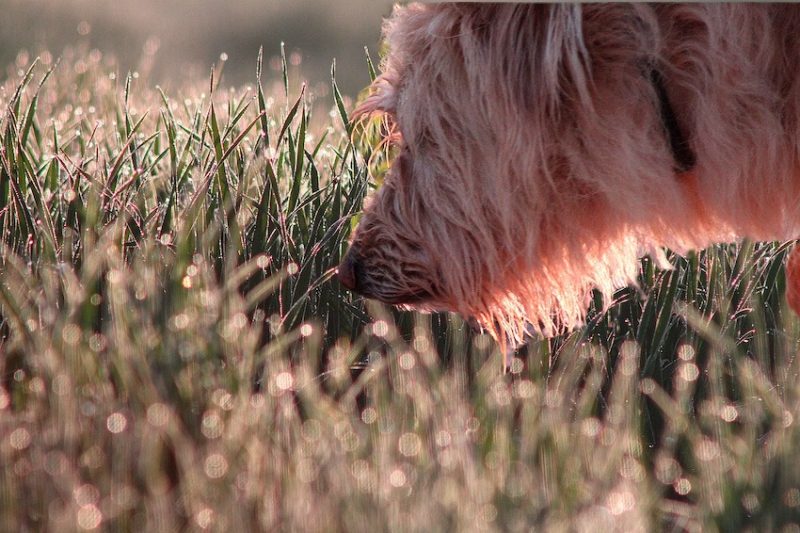 I don’t know mother, these things smells much more attention-grabbing than no matter you’re doing!
I don’t know mother, these things smells much more attention-grabbing than no matter you’re doing!
Anticipate to extend the worth of the rewards in addition to the frequency with which you dole them out when coaching instimulating outside environments.
Have You Been By accident Reinforcing Undesirable Behaviors?
When you study the facility of optimistic reinforcement, you might also start to understand a number of the methods you might be inadvertently rewarding your canine for undesirable conduct. Successfully, you might have been reinforcing these undesired behaviors by mistake!
Widespread examples of unintended reinforcement embrace:
- Letting your canine outdoors when he pesters the cat. You could be placing your canine outdoors to offer your cat a breather, however now your canine is studying that when he bothers the cat, he will get to go have enjoyable outdoors! As an alternative, attempt gating your canine in a separate room, which isn’t enjoyable on your canine and nonetheless provides your cat house.
- Petting your canine when he jumps up on you. We’re at all times excited to return residence to our doggos, however petting and interacting with our canine after they leap up in pleasure is rewarding their leaping conduct. Even yelling “Get DOWN!” is rewarding to the canine who desires consideration from you.
- Yelling at your canine for barking at folks outdoors. We might imagine we’re punishing a canine for barking by yelling at them, however in his thoughts, he’s getting consideration and interplay from you, which he loves!
You could immediately uncover that you’re by accident rewarding undesirable behaviors in a myriad of the way. Be extra cautious about the way you work together along with your canine and work on rewarding extra desired behaviors to restrict your canine’s naughty tendencies.
Operant Conditioning and the Science of Optimistic Reinforcement
To essentially perceive optimistic reinforcement coaching, we’ve to speak a bit about studying idea. This is applicable to people in addition to canine and different animals!
To start out, we have to perceive a kind of studying known as “operant conditioning.”
Operant conditioning is a kind of studying during which a conduct will increase or decreases primarily based on the conduct’s penalties (comparable to reward or punishment).
Operant conditioning is made of 4 quadrants:
- Optimistic Reinforcement
- Unfavorable Reinforcement
- Optimistic Punishment
- Unfavorable Punishment
It’s very easy to have a look at these phrases and assume that means primarily based on the connotations of “optimistic” nearly as good and “destructive” as unhealthy, however in actuality, it’s greatest to consider these kinds of studying in a mathematical sense.
POSITIVE reinforcement means you might be ADDING a reward to INCREASE the conduct
POSITIVE punishment means you might be ADDING an unenjoyable consequence to DECREASE a conduct
NEGATIVE reinforcement means you might be REMOVING a painful factor to INCREASE the specified conduct
NEGATIVE punishment means you might be REMOVING an satisfying merchandise to DECREASE a conduct
Let’s have a look at some actual examples of how these coaching strategies may play out:
Examples of Optimistic Reinforcement in Canine Coaching
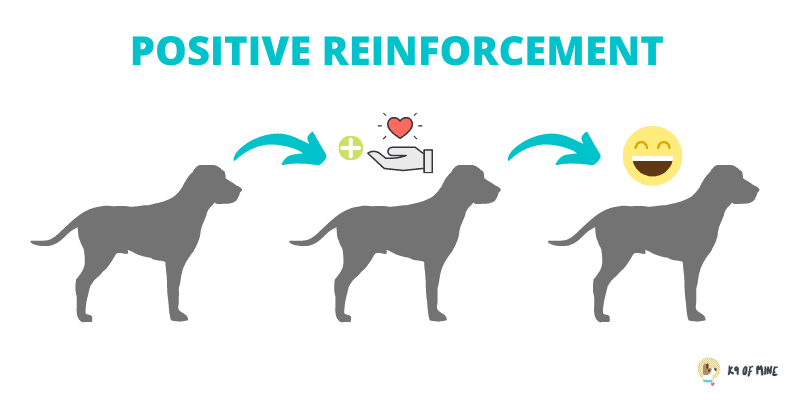
One thing is added (+) to reward and reinforce a desired conduct.
Instance: Your canine sits, so that you give him a deal with.
Your canine carried out the specified conduct (sitting), and one thing was added (the deal with). Your canine learns that when he sits, good issues occur, so he’ll make sure you sit extra usually, reinforcing the conduct.
Examples of Optimistic Punishment in Canine Coaching
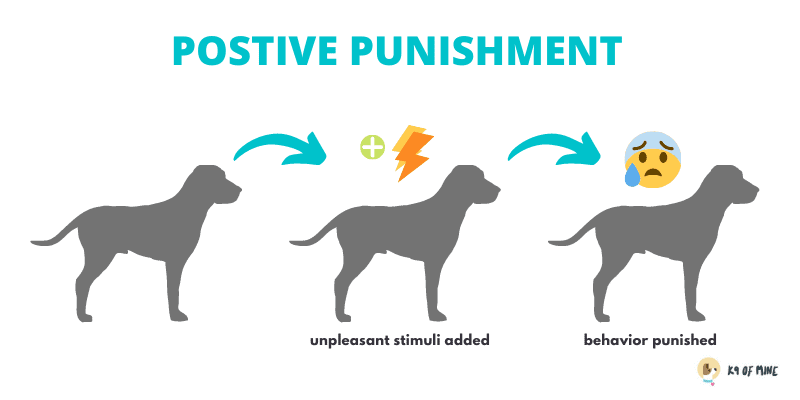
An undesirable sensation is added (+) to your canine to punish him, making the conduct lower.
Instance: Your canine barks at somebody strolling by your own home outdoors, and also you zap him with a shock collar. Your canine carried out an undesired conduct (barking) and one thing was added (the zap). Your canine has discovered that when he barks, one thing disagreeable occurred. Now he can be much less prone to bark at one thing outdoors sooner or later, reducing the barking conduct.
Examples of Unfavorable Reinforcement in Canine Coaching
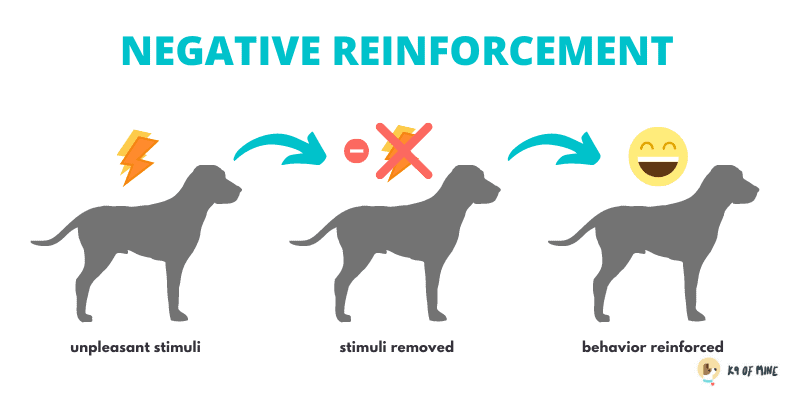
With destructive reinforcement, an disagreeable sensation is eliminated (-) as a reward when a canine performs a desired conduct, reinforcing the conduct.
Instance: Your canine has gone previous the fence boundary whereas sporting a boundary collar and is being shocked. The disagreeable stunning sensation is eliminated as soon as your canine returns to the yard boundary, rewarding him for returning to the yard.
Examples of Unfavorable Punishment in Canine Coaching
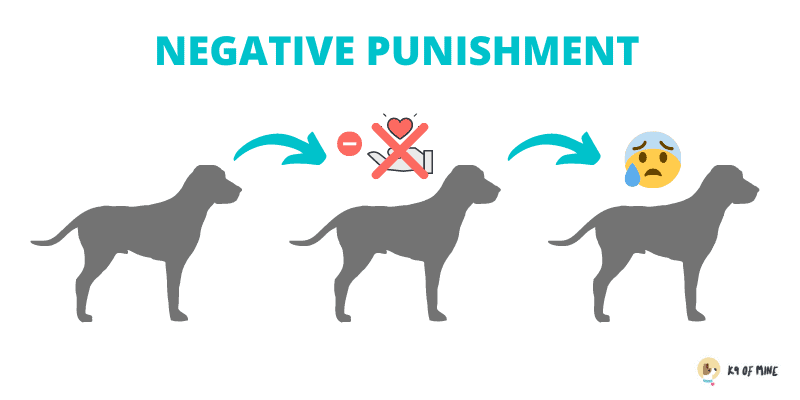
With destructive punishment, a fascinating object is eliminated (-) with the intention to lower the undesirable conduct.
Instance: Ending play and leaving the room when your canine is simply too tough with you throughout play. His conduct (being too mouthy throughout play) has made one thing good and fascinating (your consideration) go away.
Most positive-based trainers will incorporate destructive punishment into their coaching, because it’s a milder type of punishment than optimistic punishment.
Optimistic Reinforcement Coaching vs Aversive Coaching
Fashionable, educated trainers desire optimistic reinforcement coaching as a result of it has a excessive fee of success and builds on a optimistic relationship along with your canine.
Most optimistic reinforcement trainers rely totally on optimistic reinforcement, together with some mild destructive punishment (however no optimistic punishment).
Let’s discuss extra about why optimistic punishment (including one thing disagreeable to scale back a conduct) is so harmful.
The Downside with Aversive Coaching: The Hazard of Ache as a Motivator
Ache is usually a highly effective motivator, however in the long run, ache is just not the simplest approach to educate a person. It additionally comes with plenty of destructive repercussions.
It may be useful to consider these ideas when it comes to human studying as properly.
Think about a classroom the place a pupil is punished for an incorrect reply. This is able to be thought-about optimistic punishment. Embarrassment is added (+) to the coed to make the conduct (answering incorrectly) lower.
The issue is, on this scenario, you aren’t simply reducing the chance of a pupil answering incorrectly – you’re additionally reducing the chance of the coed even making an attempt to reply the query.
Why? As a result of the coed is afraid to reply the query.
There’s a probability if he solutions the query, he’ll get it improper. If he by no means tries to reply the query, he can keep away from any probability of punishment.
This occurs to canine too! It’s known as discovered helplessness, and it’s when canine will shut down and turn out to be much less prone to carry out any conduct in case it ends in punishment.

The destructive penalties go additional although.
When this pupil is punished for answering a query incorrectly, he could start to affiliate destructive feelings with the trainer, and even faculty on the whole. Over time, if this optimistic punishment is repeated, he could resolve he hates studying and needs nothing to do with faculty. What a disgrace!
In your canine’s case, using ache (or different optimistic punishments) could trigger him to worry you and coaching on the whole.
Optimistic Punishment is Harmful As a result of Canine Reply Poorly to Concern
The opposite subject with utilizing optimistic punishment and aversives that capitalize on worry and ache to handle canine conduct is that canine usually reply to worry by means of elevated aggression.
Followers of aversive strategies will boast that, with their instruments and strategies, canine will be cured of even the worst behaviors in only a few minutes.
That is true to some extent; undesirable behaviors can appear to fade by means of using aversives. However, similar to portray a broken-down automobile, the automobile could look to be in good condition whereas large issues lurk underneath the hood.
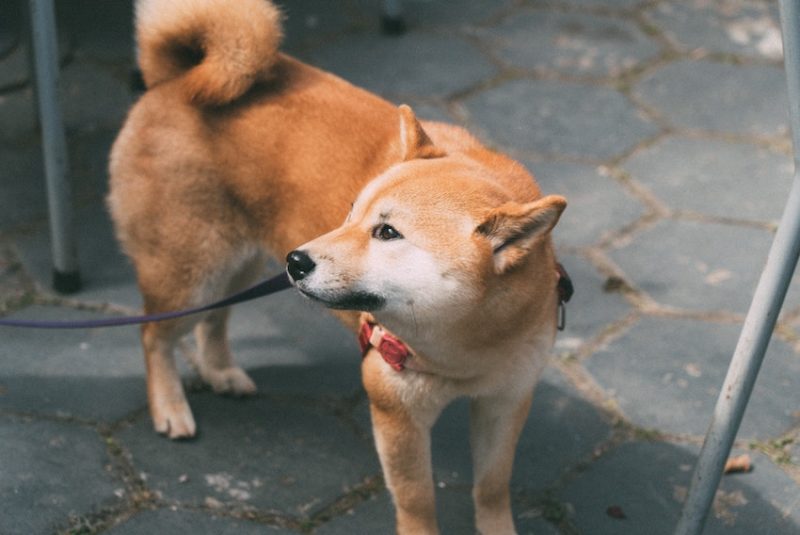
Utilizing aversives may end up in fast outcomes as a result of what they’re really attaining is conduct suppression. Habits suppression does imply that your canine will cease performing the undesirable conduct, however solely out of worry – not since you’ve helped him modify or adapt.
You’re solely fixing the symptom – not the basis explanation for the problem.
Habits is pushed by feelings, so if we’re not addressing the feelings behind our canine’s destructive conduct, we aren’t actually fixing the issue in any respect. As an alternative, we’re merely avoiding it!
Leash reactivity is a superb instance of this in follow.
Some canine will bark and lunge at different canine whereas on leash. They most frequently carry out this conduct out of worry.
Much less educated trainers could counsel utilizing a prong collar to stop the reactivity, and this may have quick outcomes. The canine will now not bark and lunge at one other canine as a result of – when he does, he experiences ache from the collar.
Downside solved, and your canine isn’t reactive anymore! Proper?
Mistaken!
It’s useful ask your self: what’s your canine studying on this scenario?
Your canine is studying that when he barks and lunges at one other canine, ache occurs. However simply as with our pupil answering an incorrect query, the canine’s studying is just not being remoted merely to the lunging and barking motion.
As an alternative, your canine is studying to affiliate different canine with ache. Which, in flip, could make your canine even extra afraid than he was previous to coaching.
As a result of aversives work by means of suppression, some house owners could undergo a few years with their canine adequately choking down worry and anxiousness with the intention to keep away from punishment. However conduct suppression at all times reaches a breaking level ultimately. And when that breaking level comes, the canine “snaps.”
That is usually the place you hear of canine changing into violently aggressive “out of nowhere.”
In actuality, the conduct is just not popping out of nowhere. The canine has possible been displaying physique language indicators of discomfort and anxiousness for a very long time, however since many house owners are unfamiliar with these cues, they go ignored.
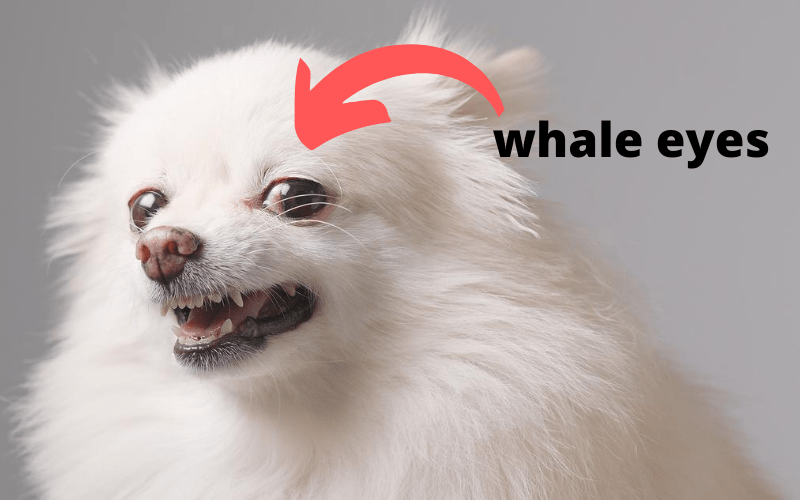 Whale eyes (seen above) is one widespread worry and stress sign in canine
Whale eyes (seen above) is one widespread worry and stress sign in canine
The canine has been punished for expressing worry by means of lunging, barking, or growling, so he doesn’t subject these warnings both.
As an alternative, he tampers down his emotions so long as he can, till the cork pops out of the bottle with a chew.
Sadly, it’s at all times the canine who’re punished by our lack of communication and steering!
Let’s return to the instance of a reactive canine on leash (partly as a result of that is one thing I’ve been engaged on with my very own canine for fairly a while now).
If we don’t need to merely suppress the barking and lunging conduct, what’s the different?
The choice is altering the canine’s emotional response to the stimuli. As an alternative of your canine associating the opposite canine on leash with worry, we would like him to affiliate the presence of the opposite canine with good issues.
This implies dishing out treats to a reactive canine upon seeing one other canine on leash.
Reactivity coaching is usually a little bit of an artwork, since you solely need to give your canine treats for wanting on the different canine when they’re not barking or lunging.
With a view to obtain this, you have to work underneath your canine’s threshold — the purpose at which he can nonetheless reply and hearken to you with out dropping his cool.
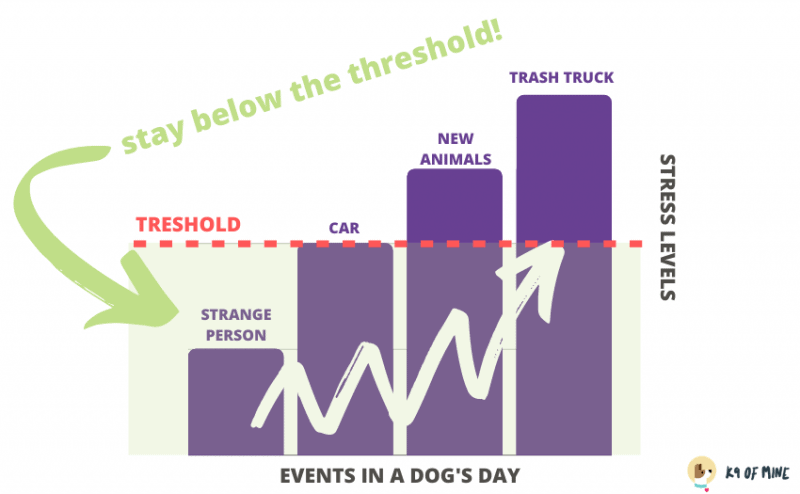
This usually requires getting extra distance from the opposite canine, and treating him when he observes the opposite canine from a secure distance whereas nonetheless being underneath his threshold and displaying comparatively calm conduct (aka not appearing like a lunging, barking mess).
Previous Coaching Strategies Vs Fashionable Coaching
People have come a great distance in understanding canine higher prior to now few a long time.
Beforehand, canine have been seen far more as practical instruments than beloved relations. Canine wanted to satisfy a strict commonplace of conduct expectations with the intention to earn their place on the farm. Searching canine wanted to trace, herding canine wanted to herd. They usually wanted to take action reliably.
Strict, harsh coaching strategies have been the norm for making certain that canine carried out the behaviors that we demanded of them shortly and effectively. And if canine couldn’t acclimate, they have been put down with out hesitation.
When canine are thought-about instruments, there aren’t any issues concerning the canine emotional state. We don’t take into account if our espresso cup is unhappy when it’s left soiled within the sink all day, and we don’t surprise if our sofa misses us once we are away.
Traditionally, we handled canine with comparable disregard. We solely cared that they carried out the behaviors we desired.

In the present day, our tradition values communication far more than it did beforehand. We’ve discovered a lot extra about how canine talk and have gained a greater understanding of the wealthy inside workings of their thoughts.
Because it seems, canine should not so completely different than us. At the very least, not in the case of studying.
Up till pretty just lately, trainers didn’t concern themselves with something apart from punishment (corrections) and reward (reinforcement). Critical canine sport rivals used choke chains, and have been regularly yanked throughout.
For a few years this was how service and police canine have been skilled too. However to have profitable outcomes with this coaching required a selected kind of canine – the uncommon canine that may very well be bullied into submission with out changing into too “gentle” or utterly breaking down.
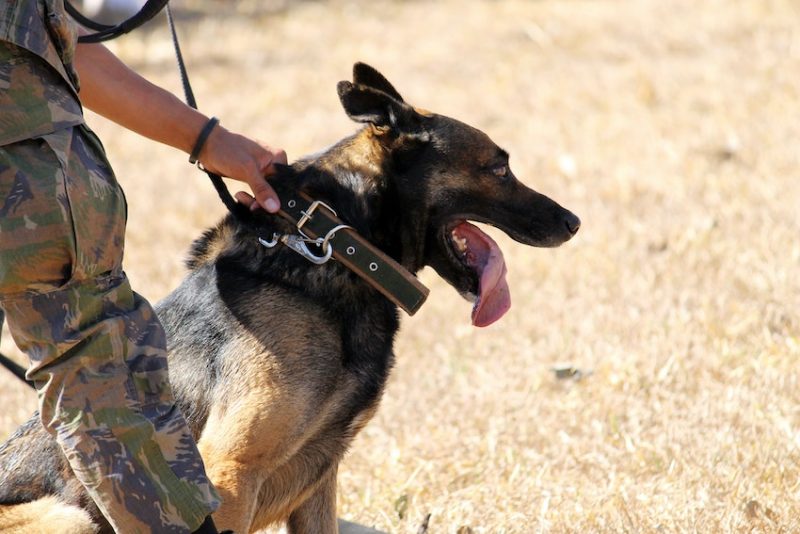
And, notably, one of many large points with this coaching was the sheer variety of canine who couldn’t face up to these sorts of harsh coaching strategies.
As famous by Karen Pryor:
Till just lately, a critical price issue within the coaching of information canine, patrol canine, and different working canine has been the flunk-out fee, the proportion of canine that “shut down,” or “simply don’t work out,” and must be offered or given away as pets regardless of months or years of funding of money and time
More and more, extra service animals and police canine are being skilled with optimistic reinforcement after trainers witnessed the nice success it yields with no destructive repercussions.
After we practice our canine with compassion and empathy, we get a win/win scenario. We get completely happy canine who’re well-adjusted and have discovered to thrive in our world of human guidelines whereas nonetheless sustaining their particular person spirit.
With aversive-based coaching and debunked dominance/alpha coaching, the tip result’s fearful, anxious canine who’ve discovered to not totally belief their people.
One of the best-case state of affairs is discovered helplessness, and the worst case is a chew that occurs at some point “out of nowhere.”
Optimistic Reinforcement Is Tough As a result of It Requires Empathy
Optimistic reinforcement primarily based coaching has so many detractors for one easy motive: It’s not straightforward.
Optimistic reinforcement coaching requires listening to your canine and studying how you can acknowledge his communication alerts. It requires plenty of empathy and understanding.

It takes plenty of psychological vitality to really take into account how your canine experiences the world, which is dramatically completely different than our human expertise!
It additionally takes great endurance, as optimistic reinforcement works in the direction of actual, genuine conduct change, and that doesn’t occur in a single day.
Actual change occurs slowly. Rather more slowly than we’d like.
Optimistic reinforcement-based coaching requires far more time and dedication than conventional aversive coaching. However the outcomes are rewarding sufficient to make all of the work worthwhile.
Not solely will you be altering your canine’s mindset, however you’ll additionally strengthen your bond in a method you by no means might by means of punishment.
For me personally, witnessing the change in my very own canine felt a bit like a mini miracle, and it impressed me to be aware of the change I need to implement in my very own life.
Enhancements Are Delicate with R+ Coaching: Change Takes Time
Change is sluggish. So sluggish, that it’s very straightforward to overlook.
Think about you have been requested to check a small plant for 5 minutes every day, photographing and documenting what you noticed.
Every day, a professor may come to you and ask what progress you noticed the plant make. When flipping between that day’s notes with the present {photograph} of the plant and the beforehand day’s notes and {photograph}, you’d say nothing had modified in any respect.
However, after a month, should you regarded again to your first plant {photograph} and notes, you’d little doubt acknowledge that – really – so much has modified.

Canine coaching is usually a bit like that generally.
It appears like change occurs so slowly, you could surprise if it’s occurring in any respect. Some days your coaching takes one step ahead and two steps again.
However after one month, three months, or six months, should you really take into account the place you have been initially of your coaching, you’ll be amazed at how far you and your doggo have come.
Change is like that for all of us. There aren’t any shortcuts or straightforward solutions. There aren’t any magic elixirs. Solely laborious work. However that onerous work is at all times rewarded.
Optimistic Reinforcement Troubleshooting: Why Is It Not Working?
Really feel like optimistic coaching isn’t working for you? Listed here are some widespread areas the place house owners fail:
- You’re not utilizing fascinating sufficient rewards. The most typical mistake house owners encounter with optimistic reinforcement coaching is just not sufficiently addressing motivation. Kibble gained’t reduce it with R+ coaching, particularly while you’re battling towards ingrained behaviors which are self-rewarding for the canine (like nuisance barking, chewing, and so on).
- You aren’t delivering rewards shortly sufficient. Should you’re giving your canine a deal with for sitting after he’s already gotten up and approached you, you’re too late! Strive utilizing a clicker or just carry a deal with bag (or simply stuff ‘em in your pocket) as a way to dispense treats extra shortly and on the right time.
- It is advisable to follow extra. Your canine gained’t proceed to carry out a desired conduct just because he was rewarded as soon as – it’s important to reinforce your coaching time and again earlier than it’ll really sink in on your canine.
- You’re working round too many distractions. Many homeowners will label their canine as “cussed” after they gained’t reply to a recall command (like “come”) outdoors. However in actuality, it’s far more tough for a canine to focus outdoors – which is filled with wonderful sights, sounds, and smells – than inside his residence the place he spends most of his day.
Asking your canine to observe your instructions at a park is a bit like asking a toddler to take a seat down and take an algebra quiz at Disneyland. It’s going to be awfully tough!
As an alternative, at all times begin coaching indoors, then transfer to a well-known space outdoors (like a again yard) earlier than even trying instructions in a brand new setting.
Optimistic Reinforcement FAQs
Although optimistic reinforcement strategies are gaining reputation, your entire R+ coaching model sparks plenty of questions amongst house owners. We’ll attempt to reply just a few of the most typical ones beneath.
What if my canine isn’t meals motivated?
Some house owners discover that meals isn’t as fascinating a reward as a sport of tug or fetch. However the fact is that 99% of canine are certainly VERY meals motivated – you simply may not be utilizing a really fascinating meals!
Take into account the boring kibble your canine will get day-after-day for meals isn’t very engaging for coaching. As an alternative, attempt one thing particular and smelly – the meatier the higher!
Should you suppose your canine isn’t meals motivated, attempt utilizing scorching canine slices, string cheese items, or chunks of rotisserie hen, and I feel you’ll discover your canine is lots motivated by the proper of meals.
Don’t completely different canine want completely different studying kinds?
Whereas it’s true that completely different canine could also be extra motivated by sure rewards than others (comparable to a sport of fetch vs a deal with), all canine study greatest by means of optimistic reinforcement and by avoiding optimistic punishment.
Plenty of “balanced” trainers (aka skilled who use aversives like shock collars and prong collars) will say that completely different canine study in another way. They may say your canine is simply too cussed for optimistic reinforcement coaching. That is largely an excuse to make use of aversives, which might have sooner, simpler outward outcomes, however trigger vital psychological injury.
There aren’t any dangers to utilizing optimistic reinforcement coaching, however there are large potential dangers to utilizing aversives like shock collars. Quite a few experiments — comparable to this 2017 examine, revealed in Journal of Veterinary Habits Scientific Purposes and Analysis
— have proven that canine skilled with punitive strategies usually exhibit drawback behaviors, together with worry and aggression.
Different research, like this 2020 pre-print, have additionally proven that canine skilled with aversives expertise extra stress and present greater cortisol ranges after coaching than canine skilled by means of optimistic reinforcement.
On high of the scientific analysis, many animal welfare and animal conduct organizations, comparable to (e.g., American Veterinary Society of Animal Habits and the Affiliation of Skilled Canine Trainers have revealed statements denouncing using aversive coaching strategies that inflict ache (together with shock collars, choke chains, and prong collars, amongst others), and several other international locations together with Denmark, Germany, and Finland have really banned using such collars due to the potential for bodily damage to the canine
Optimistic reinforcement is the most secure and handiest coaching possibility, whatever the subject.
Do I’ve to make use of a clicker?
Not should you don’t need to!
Clickers are favored by many house owners and trainers on account of their exactness and consistency. We’d counsel giving clicker coaching an opportunity – it could possibly definitely really feel awkward and cumbersome at first, however with a little bit follow you could start to seek out clicking as pure as respiratory!
Nonetheless, should you actually can’t stand the clicker, you may at all times use a marker phrase like “Sure!” Ensure you use a marker phrase that isn’t already used repeatedly – the phrase ought to be pretty distinctive and never by accident spoken usually.
That is why “good canine” isn’t an amazing marker-word; we’ll usually bathe our doggos with reward and acclimations of “Good boy” with out dishing out a deal with. This out-of-context use of the marker phrase can break its effectiveness.
Additionally ensure you are utilizing the identical tone and intonation on your marker phrase. Consistency is basically essential!
Do positive-based trainers ever inform a canine “no?”
It is a widespread false impression about optimistic reinforcement-based trainers!
The overwhelming majority of R+ trainers haven’t any subject with delivering a verbal interrupter like “No,” as long as the coach can be redirecting the canine to a special, extra applicable conduct and rewarding the canine in consequence.
Whereas issuing a verbal interrupter isn’t damaging to your canine, it’s not notably useful both since you aren’t telling your canine what he ought to be doing as a substitute! The objective is to information your canine into making the fitting selections and reinforcing these good choices!
***
Our tradition has very a lot glorified canine to an unrealistic standing. Canine should not animals born to cater to our each whim and performance as puddles of affection 24/7.
They’re people with their very own motivations and needs. It’s YOUR job to encourage your canine, and the perfect type of motivation and coaching can be optimistic reinforcement-based!
As you may see, there are a ton of advantages to optimistic reinforcement coaching. Your canine will definitely love this coaching model and sure begin choosing up classes and abilities extra shortly, however you’ll possible discover that you just get pleasure from this coaching model extra too!
Do you utilize optimistic coaching strategies to show your canine abilities? What sorts of issues do you want about this strategy?
Have you ever observed that your canine appears to get pleasure from coaching periods extra? Tell us your experiences — in addition to any questions you might have — within the feedback beneath!
